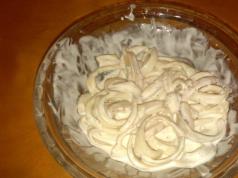chicken schnitzel rich in vitamins and minerals such as: vitamin B1 - 17.1%, vitamin B5 - 18.3%, vitamin B12 - 11.3%, vitamin PP - 27.8%, phosphorus - 26.3%, manganese - 11 .6%, copper - 23.3%, selenium - 44.7%
Benefits of Chicken Schnitzel
- Vitamin B1 is part of the most important enzymes of carbohydrate and energy metabolism, providing the body with energy and plastic substances, as well as the metabolism of branched-chain amino acids. The lack of this vitamin leads to serious disorders of the nervous, digestive and cardiovascular systems.
- Vitamin B5 participates in protein, fat, carbohydrate metabolism, cholesterol metabolism, the synthesis of a number of hormones, hemoglobin, promotes the absorption of amino acids and sugars in the intestine, supports the function of the adrenal cortex. A lack of pantothenic acid can lead to damage to the skin and mucous membranes.
- Vitamin B12 plays an important role in the metabolism and transformations of amino acids. Folate and vitamin B12 are interrelated vitamins involved in hematopoiesis. A lack of vitamin B12 leads to the development of partial or secondary folate deficiency, as well as anemia, leukopenia, and thrombocytopenia.
- Vitamin PP participates in redox reactions of energy metabolism. Inadequate vitamin intake is accompanied by a violation of the normal state of the skin, gastrointestinal tract and nervous system.
- Phosphorus takes part in many physiological processes, including energy metabolism, regulates acid-base balance, is part of phospholipids, nucleotides and nucleic acids, is necessary for the mineralization of bones and teeth. Deficiency leads to anorexia, anemia, rickets.
- Manganese participates in the formation of bone and connective tissue, is part of the enzymes involved in the metabolism of amino acids, carbohydrates, catecholamines; necessary for the synthesis of cholesterol and nucleotides. Insufficient consumption is accompanied by growth retardation, disorders in the reproductive system, increased fragility of bone tissue, disorders of carbohydrate and lipid metabolism.
- Copper is part of the enzymes that have redox activity and are involved in the metabolism of iron, stimulates the absorption of proteins and carbohydrates. Participates in the processes of providing tissues of the human body with oxygen. Deficiency is manifested by violations of the formation of the cardiovascular system and skeleton, the development of connective tissue dysplasia.
- Selenium- an essential element of the antioxidant defense system of the human body, has an immunomodulatory effect, is involved in the regulation of the action of thyroid hormones. Deficiency leads to Kashin-Bek's disease (osteoarthritis with multiple deformities of the joints, spine and limbs), Keshan's disease (endemic myocardiopathy), and hereditary thrombasthenia.
The complete guide to the most useful products you can see in the app
Schnitzel properties
A real schnitzel cooked according to all the rules, even despite its rather impressive size, is eaten quite easily and rarely remains on a plate. This meat product is a pre-breaded chop, and then fried in oil.
At proper preparation ready-made schnitzel is distinguished by a golden color and a crispy crust that easily separates from the meat. By the way, the word "schnitzel" along with the dish itself came to our country from Germany. FROM German language"schnitzel" is translated as "tenderloin", that is, a simple piece of meat.
According to some sources, the official beginning of the schnitzel dates back to the report of Field Marshal Radetzky as early as 48 of the 19th century. In this document, he mentions a rather interesting invention of the Italians - veal chop, dipped in a beaten egg before frying, and then rolled in breadcrumbs.
It is customary to serve a ready-made schnitzel with only a piece of fresh lemon, which is squeezed onto the meat during the meal. For additional aesthetics, you can decorate ready meal sprig of parsley and put canned black olives on the schnitzel. At the same time, no gravies, sauces, and even more so ketchups should not be served with schnitzel.
Interestingly, schnitzel is served differently in each country. For example, in Vienna they serve him a special potato salad but on a separate plate. At the same time, the composition of such a salad may vary, but the essence remains unchanged - warm boiled potatoes and purple onions with green lettuce. All ingredients are seasoned with a mixture based on beef broth, vegetable oil and wine vinegar.
Schnitzel types
The types of schnitzels are determined by the choice of meat used to prepare this hearty meal. For example, many people prefer veal or beef, while others like to cook pork schnitzel. In addition, the types of schnitzel include a meat product based on chicken fillet or turkey meat.
Depending on the method of cooking, two types of schnitzels are distinguished - chop and chopped. The first provides for a short beating of a piece of meat, and the second option is characterized by giving the necessary shape from small pieces.
So, the calorie content of the schnitzel also depends on the variety of the original semi-finished product. For example, pork schnitzel is considered the most nutritious, and chicken and turkey meat differs in the least caloric value.
The composition of the schnitzel
The composition of the schnitzel can be easily determined by the definition of this dish - a thin piece of well-beaten meat (veal, beef, lamb, pork, chicken or turkey), as well as breading. As the last component in the composition of the schnitzel, as a rule, breadcrumbs or crushed into crumbs are used. White bread, egg, slightly whipped, as well as a variety of spices as desired.
Schnitzel Calorie 403 kcal.
The energy value product Schnitzel (Ratio of proteins, fats, carbohydrates).
"Segment" - this is how the name of this traditional Austrian dish, popular all over the world, is translated from German. Today there are many original variants Viennese chop, where chicken schnitzel remains the most popular, the calorie content of which does not exceed 200 kcal per 100 grams. This tender fillet in melt-in-your-mouth batter represents the sophistication of European cuisine and at the same time allows you to occasionally enjoy yummy even on a diet.
Varieties of Austrian Schnitzel
As the name already implies, we owe the appearance of the Wiener Schnitzel to the Austrian chefs of the 19th century. It was then that the thinnest veal chop in an unusual breading was first cooked. It is the batter that distinguishes the schnitzel from the usual chop, and the method of cooking deep-fried meat from the escalope.
The schnitzel was so liked by the high-ranking public that it quickly spread beyond the borders of the homeland.

Subsequently, in different European countries, their own schnitzels appeared, based, of course, on classic recipe Austrians, but with their own subtleties.
- Hunting schnitzel - the brainchild of the Germans, is prepared from pork or beef chop in mushroom and tomato sauce.
- French, or Parisian schnitzel - thin veal chop, which is fried without breading and batter in the usual way.
- Berlin Schnitzel is made from cow's udder. First, the udder is boiled for about an hour in plain water, and then simmered for another 4 hours in a broth with vegetables and roots.
Only after the product becomes soft, it is cut into thin layers and cooked like a Wiener schnitzel, breaded and battered.
- Rzycek is a similar Viennese schnitzel, but in Czech. Everything is here, as in the original: chop, breading, but the meat is not deep-fried, but in the usual way.
How many calories in chicken schnitzel
As you can see, the schnitzel has quite a few varieties, but we are specifically interested in chicken, so we can calculate the calorie content per 100 grams using two options: Parisian schnitzel and Viennese, where chicken is acceptable for cooking, but at the same time, the dish is breaded, therefore without it it will have different indicators of energy intensity.
Calorie breaded Wiener schnitzel
The classic Viennese schnitzel recipe includes 200 g chicken fillet, salt and spices, and suggests using one chicken egg and 50 g breadcrumbs.

- On average, 1 egg of a selected category weighs 55-60 g, which is 94 kcal already in terms of grams of the product.
- The calorie content of breadcrumbs is very high - 173 kcal per 50 g.
- As a result, 110 g of such a breading, intended for the preparation of 1 schnitzel, accounts for 268 kcal.
- A two-hundred-gram chicken fillet (1 serving of schnitzel) is 226 kcal.
After all the additions and divisions, you can easily calculate that the calorie content of one 300 g chicken schnitzel is 490 kcal, while 100 g of such a dish “weighs” 159 kcal, and this is without roasting.
Calorie content of the Parisian schnitzel without breading
With a Parisian schnitzel, everything is easier. There is no breading, so the calculation is based solely on the net weight of the meat.
Parts of the chicken and their effect on the calorie content of the schnitzel
It’s also impossible to say exactly how many calories are in a chicken schnitzel until we clarify the composition of the recipe and find out exactly which part of the chicken was taken to make the “patty”: breast or fillet from the thigh.
- For example, white breast chicken is considered the lowest fat, high protein and low calorie type of meat.
It is for this that broilers are so valued by those who monitor the quality of their food. There are only 110-113 kcal per 100 g of such meat, while carbohydrates are 0 g, fat is 1 g, and protein is as much as 23 g.
- The second "meat" place in the chicken carcass is the thighs, they have a more significant calorie content - 185 kcal per 100 gram serving. Here there is more fat - 11 g, and less protein - 21 g. But such a schnitzel will turn out to be more juicy and tasty.
How frying in oil affects calories
As you know, frying in oil is not the best (in terms of diet) way of cooking, because it adds a lot of calories to the dish.
- According to experts, during the frying process, the meat absorbs 20% of the oil that is used in cooking. So, the usual frying of a clean, not breaded, Parisian schnitzel with 50 ml of oil in a pan will add 130-150 kcal to the calorie content of the breast.
- At the same time, we must not forget that without breading, the moisture from the meat will evaporate, the weight of the fillet, respectively, will decrease, and the calorie content of the product will become more concentrated.
Thus, the Parisian schnitzel from chicken breast by the time it hits the table, it will reach 200 kcal per 100 g.
- In the case of the Wiener Schnitzel, it is used for deep frying. We hasten to dispel all the myths about the catastrophic harmfulness of this method of frying.
- Firstly, as scientists have found out, deep-frying is less caloric for products, because, getting into hot oil, a dense crust immediately forms on the surface of the product, which prevents the oil from penetrating inside.
- Secondly, this very crust keeps all the juices of the meat inside, so the schnitzel turns out to be more tender.
- Thirdly, this fast way heat treatment makes it possible to preserve as much as possible useful material in the product.

- But it should be borne in mind that for high-quality deep-frying, the cooking temperature must be at least 180 ° C, so that, getting into the oily environment, the schnitzel immediately hisses and quickly becomes covered with a crispy shell. The calorie content of such a schnitzel is 175 kcal per 100 g.
Summing up, we can say that not always breading and deep-frying obviously make the dish even more “heavy”. As we were able to find out, the Viennese chicken schnitzel has less calories than the "naked" Parisian, and this despite the presence of eggs and breadcrumbs in the recipe.
Well, you must admit: there is nothing wrong if you allow yourself, at least once a month, to taste juicy, tender, chicken fillet in a delicious crispy crust.








